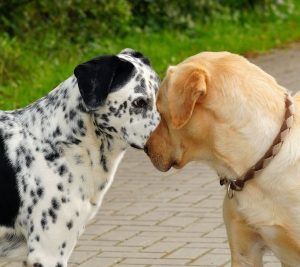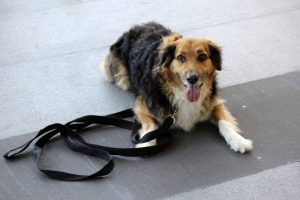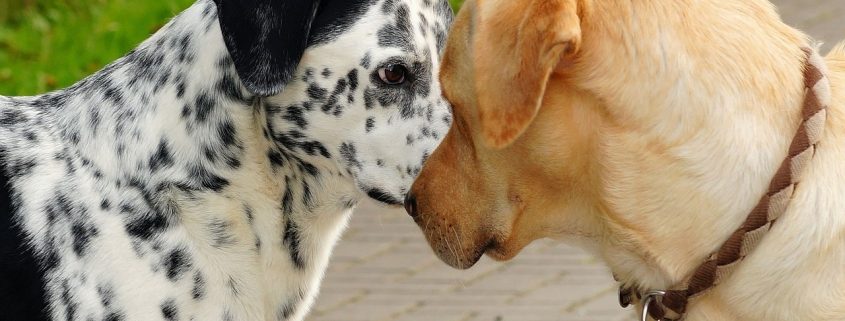Ask Crystal: New Roommates Take Time to Warm up

Dear Crystal,
I recently adopted a new dog. My current dog (female, 1.5 years old) is nervous around him but not exactly aggressive. She just has a lot of fears (ex. growls or barks a lot at outside noises) but she has never been aggressive to other dogs. We introduced the two in a neutral setting and had them walk with each other.
The adopted dog seems to show no interest in my current dog, He won’t even sniff or anything. He does look at her when she moves around (he has his own corner for his own space) and both are on leashes. They don’t exactly growl all the time at each other but the adopted dog starts showing teeth and growling when my current dog goes near him. I am giving both of them separate spaces but I am worried since the adopted dog seems to not like my current dog who seems very interested in him.
Is it just because he (adopted dog) is on his bed and is nervous since this is a new environment? I was told that he got along with other dogs at the shelter and there were no issues (I have seen multiple videos of him in those settings so I’m positive he gets along with other dogs) so I’m afraid it might just be my dog that he doesn’t like.
My current dog has started growling a little when she sees my adopted dog (totally fine on our walks and they walk side by side but sometimes rushes ahead if he gets too close as well). We make sure to pet both to not let her get too jealous.
Any advice of what to do and if I should just give it time? My current dog is only 5.5 pounds (malitpoo) and the adopted dog is 26 pounds so I’m nervous he might bite her.
Sincerely,
Roommate troubles
Dear Roommate,
Thanks so much for reaching out. It sounds like you are really doing a lot of things right. It is pretty normal to worry in the beginning of adopting a new dog. It is true that not all dogs will get along, they do have personality clashes just like we do. How you introduce them in these beginning weeks really does impact their relationship though so it’s important to take time now in the beginning to get them off on the right foot.
Decompression is for Dogs Too!
Decompression is one aspect of introductions that the majority of people do not know about. When dogs lose their homes and end up in a shelter, they experience a trauma. This trauma causes the release of stress hormones in their body. They need a quiet and as stress free environment to recover in. If they are not allowed the time their body needs to balance, the stress hormones build up and can cause a variety of negative effects on the body. Every dog has different time needs for decompression. We usually say at least 3 days for the body to recover but some dogs need weeks just depending on their personality. More anxious, fearful dogs usually need more time and space than a more confident dog.
I don’t know how long you have had the new dog and when you started introducing him to your dog, but part of the issue could be that he needed that decompression time to recover before being introduced to your dog. Not giving a dog a decompression period can make them behave more reactive or aggressive than they would normally if they were not stressed. It may be a good idea to go back to the beginning and start over with a decompression period.
A good way to judge whether a dog is ready to move out of decompression is their behavior. While it can be hard to know what is going on in a dog’s body, their behavior can give us a pretty good indicator of how they are feeling. A dog’s first need is to feel safe. Until the dog feels safe in their new environment, they aren’t able to learn. Dogs that feel unsafe may not be going to the bathroom normally, they may not eat or drink normally and they may be withdrawn. When the new dog is engaging with its environment, with you and behaving normally in terms of bodily functions, that is a good indicator they are ready to move on from decompression. This is when we can start to introduce them to other pets and people. If your new dog is having any of the above issues with eating, drinking or going to the bathroom, take a step back and give him quiet time away from the other dog until he seems to be behaving normally.
The other good part about the decompression period is that the dogs can get used to the other dog’s presence without actually having to see them or interact with them. They can smell and hear them which is usually a more tolerable level of exposure for most animals. During this period, we scent swap bedding or rub hand towels on each dog and swap the smells. This can help them begin to accept the other animal as part of their social grouping.
The Next Step: Visual Exposure
When the dogs are actually out of decompression, we can start to visually expose them through baby gates for short periods while feeding yummy treats to reinforce calm behavior while looking at the other dog. If there is any growling or aggressive behavior, then move farther away from the gates and work from whatever distance they are not reactive. Each day slowly move closer as the dogs are showing comfort. If both dogs are showing friendly or calm body language, we can move to having them on the same room on leashes and reinforcing for friendly, calm behavior.
In addition to the visual exposure, we can add tandem daily walks to the introduction. You will need one handler per dog. In the beginning, you can have each dog on the outside of the handlers so they aren’t walking right next to each other, and they can’t reach each other yet. As the dog get into the rhythm of the walk, if their body seems relaxed, you can do a three second greeting. Three seconds is usually not long enough for anything bad to happen. If you see stiff body language or any growling, move the dogs away and keep walking. That usually means they need more time to become comfortable. Keep taking these walks daily. Again, the goal is to be very zen and boring on these walks.
When you go back inside the home, separate the dogs into their individual spaces. Dogs have a much harder time inside the home where the space is confined. They also may feel more territorial inside the house than outside on a walk. Many dogs seem totally fine together outside but inside the home they are showing aggressive behaviors towards each other.
Sharing Spaces
 The next step is working on getting them used to each other inside the home and in common spaces. I like to use leashes and training tethers at this point. I have a small house with an open floor plan so I attach the dog’s leash to the outside of the door and shut the leash in the door. I put a nice comfy bed by it and toss the dog treats for behaving calmly. You will have the other dog across the room on a leash and feed that dog treats for behaving calmly. If you think one of the dogs is going to try to approach the other in his space, keep them on leashes attached to something. Do this daily for increasing amounts of time. This way the dogs can get used to each other’s presence without the pressure of interacting or having the other dog come into their space.
The next step is working on getting them used to each other inside the home and in common spaces. I like to use leashes and training tethers at this point. I have a small house with an open floor plan so I attach the dog’s leash to the outside of the door and shut the leash in the door. I put a nice comfy bed by it and toss the dog treats for behaving calmly. You will have the other dog across the room on a leash and feed that dog treats for behaving calmly. If you think one of the dogs is going to try to approach the other in his space, keep them on leashes attached to something. Do this daily for increasing amounts of time. This way the dogs can get used to each other’s presence without the pressure of interacting or having the other dog come into their space.
When the dogs are no longer growling, stiff or showing other signs of discomfort at the other approaching or being in each other’s space, you can begin to let them have time together where they are dragging their leashes but able to move about. Large open spaces are better for this than confined spaces like hallways, doorways, stairways or kitchens that also have a lot of excitement from the presence of food. I still suggest periods of time where they are either separated or on leashes if they seem like they need a break or if they have had a big day and are tired.
It will probably take more time to see if their personalities are a good fit or not. There are some different things that can cause problems sometimes with different dogs. Sometimes if we have two very strong similar personalities that can be a big problem. We see that a lot when people adopt two females that are too similar in personality, age and size but it could happen between males and females. There can also be issues when the dog’s energy levels that are just way off, meaning one dog wants to play all the time and the other doesn’t. Some dogs can be possessive of owners and that can cause tension.
My guess would be his behavior is largely being influenced by stress and just not knowing your dog or you and what the routine is. It’s a lot for a dog to have to deal with all at once. Based on what you have told me it seems more like a dog that needs more space and time than anything in particular about your other dog. Your dog is also feeling uncomfortable and needing some space. I would take some steps back such as keeping them on leashes inside, rewarding calm behavior, taking tandem walks and giving them breaks from each other. As far as the size difference, while it is a large size difference, it doesn’t sound like you have anything in particular to worry about with this dog hurting your dog. Most dog disagreements are just a lot of noise. That is because they really don’t want to hurt the other dog but rather intimidate it and make it back off. The fact that he plays nicely with other dogs is a good sign, but we aren’t putting them in home situations at the animal shelters so that’s when a lot of things can pop up in the home.
Just Take It Slow
You really cannot go too slow in a dog introduction. There is absolutely no downside to taking things very slowly. There are huge downsides to rushing things. It’s important to remember we are trying to build a relationship between the two dogs and also between the new dog and you. The biggest part of building a relationship is building trust. That happens when we respect what the dogs are trying to tell us. If they say they need more space and time, we should give them that. In addition, it is important to prevent disagreements and fights as much as possible to help build that relationship. It is much harder to repair then to prevent problems.
Until next time,
Crystal
Submit your own pet behavior question for Crystal here:







